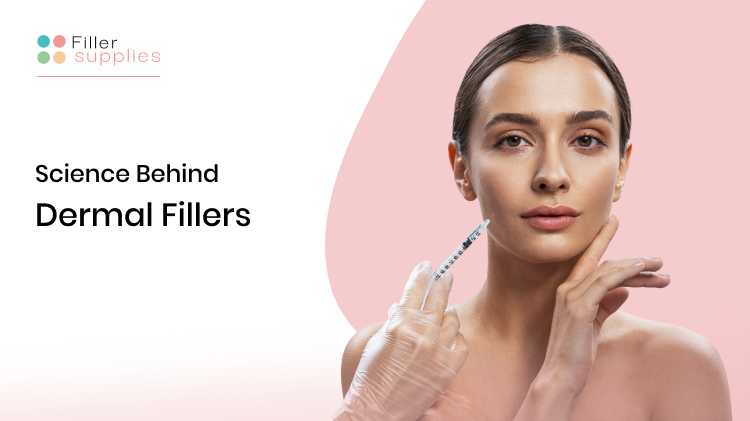The Science of Dermal Fillers: What Are They and How Do They Work?

Dermal filler procedures might create truly magical results when it comes to facial enhancement and rejuvenation. They provide thousands of patients all over the world with an attractive and more youthful appearance in a safe, effective, and minimally invasive way.
But what is the science behind dermal fillers? What exactly they are and how do they work? Let’s figure it out together by going through this article. How about exploring the scientific side of dermal filler injections right away?
ON A SIDE NOTE:
Are you interested in unraveling the secrets to achieving youthful skin with Revolax? If so, delve into our article “Discovering Revolax: The Secret to Youthful Skin” for comprehensive insights into this innovative approach to maintaining a youthful and rejuvenated appearance.
What Are Dermal Fillers?
Injections of dermal fillers belong to the most popular procedures offered by aesthetic medicine. Most patients choose them as their number-one treatment for the improvement of their skin. Below, you will find a short overview of the definition, types, and popular brands of dermal fillers.
Planning Liquid Rhinoplasty? 7 Key Considerations Await You at FillerSupplies. Before enhancing your nose with a non-surgical rhinoplasty, explore these crucial factors for a well-informed decision. Your path to nose refinement starts here.
Definition
Dermal fillers (also known as soft tissue fillers) might be defined as injectable treatments that effectively enhance and rejuvenate the overall appearance of a patient. Their high level of safety, strong effectiveness, and long-lasting duration have already won the hearts of healthcare providers worldwide.
ON A SIDE NOTE:
Due to their minimal invasiveness, dermal filler injections function as risk-free alternatives to a number of plastic surgery procedures (such as facial lifting).
Types
Depending on the main active substance employed in their composition, dermal fillers might be divided into the following types:
- Hyaluronic acid (HA) dermal fillers;
- Calcium hydroxyapatite dermal fillers;
- Poly-L-lactic dermal fillers;
- And many more.
ON A SIDE NOTE:
Synthetic hyaluronic acid is considered to be the most widespread dermal filler material. Oftentimes combined with lidocaine hydrochloride (a local numbing agent), it moisturizes the skin in a pain-free way.
Popular Brands
Contemporary aesthetic medicine offers a wide variety of dermal filler brands. Below, you will find the list of the most popular ones:
- Belotero, Juvederm, Restylane (hyaluronic acid fillers). The most popular hyaluronic acid fillers are Belotero Lips (Shape & Contour), Belotero Intense, Belotero Soft, Juvederm Volbella, Juvederm Voluma, Juvederm Ultra XC, Restylane Kysse, Restylane Defyne, and Restylane Refyne;
- Radiesse (calcium hydroxyapatite fillers). The product line of Radiesse fillers includes several solutions of different volumes, starting from Radiesse 0.8ml and ending with Radiesse 3ml. They all exist either with or without prefilled lidocaine hydrochloride in their composition;
- Sculptra (poly-L-lactic acid fillers). Unlike the vast majority of the above-mentioned fillers, Sculptra is considered to be a semi-permanent solution that lasts for an exceptionally durable time period;
- And other fillers.
ON A SIDE NOTE:
It is the task of a medical professional to define which dermal filler brand is going to fit your needs best. Such a decision is usually made after the allergy skin testing and overall health checkup of a patient.
How Do Dermal Fillers Work?
Dermal fillers work in a minimally invasive way that does not usually initiate any kind of unwanted immune response. Check out their treatment protocol, indications, and expected results by going through the information below.
Treatment Protocol
According to its treatment protocol, an injection of a dermal filler should be performed exclusively by a certified healthcare provider, perfectly aware of facial anatomy and capable of using the most appropriate injection technique. Under normal circumstances, the procedure looks as follows:
- Firstly, a healthcare provider thoroughly investigates the health condition of a patient to make sure that it is absolutely safe to administer the dermal filler in this particular case;
- Secondly, a healthcare provider prepares the skin of a patient for the injection. If needed, a topical numbing agent might be applied to the injection site;
- Thirdly, a healthcare provider administers the dermal filler beneath a patient’s skin by means of avoiding an unintentional injection into a blood vessel.
ON A SIDE NOTE:
Having a dermal filler injected beneath the skin is a virtually pain-free procedure. It provides a patient with soft tissue augmentation and smoothing in a comfortable way.
Indications
The main purpose of dermal fillers is the facial rejuvenation and enhancement of a patient. More precisely, they might be used to:
- Reduce facial wrinkles (namely, dermal fillers effectively smooth lines all over the facial oval, starting from nasolabial folds and ending with perioral lines);
- Smooth acne scars;
- Compensate for the age-related facial volume loss;
- Augment the lips and improve their contour;
- And so on.
ON A SIDE NOTE:
One of the main benefits of dermal filler treatment is that it has the power to accelerate the natural production of collagen and elastin.
Contraindications
Due to their high safety, dermal fillers do not have many contraindications. Still, they should not be administered if a patient is allergic to any component in their composition, has a serious chronic disease, or experiences ongoing skin irritation around the injection site.
ON A SIDE NOTE:
It is also recommended to postpone a dermal filler treatment for a certain time period if a patient is pregnant or breastfeeding.
Expected Results
Dermal fillers tend to create instantly visible and long-lasting results. By means of minimizing skin folds, plumping lips, and accelerating collagen production, they effectively improve the appearance of a patient for a durable time period.
Depending on a patient’s individual health condition, skin type, and age, dermal fillers might remain beneath their skin for a time period that equals six to twenty-four months. Moreover, their results might be substantially prolonged by periodical touch-up injections.
ON A SIDE NOTE:
Dermal fillers are expected to improve a patient’s skin condition by means of reducing static wrinkles. While botulinum toxins, in their turn, aim to take care of dynamic wrinkles by means of relaxing facial muscles.
Possible Side Effects
Under normal circumstances, a patient is not expected to experience any adverse reactions after undergoing injections of dermal fillers. However, such side effects as temporary skin irritation (including redness, itching, or swelling) and pain might appear after the procedure.
Luckily, these side effects have a temporary character. They tend to fade away in two to five days after the injection and do not usually require any medical supervision. Still, a patient should inform a healthcare provider in case of having any unwanted symptoms after the administration of dermal fillers.
ON A SIDE NOTE:
Unintentional injections of soft tissue fillers into blood vessels might cause serious side effects. Therefore, it is exceptionally important to rely on a knowledgeable healthcare provider to avoid such situations.
Radiesse for Cheeks: Before and After Transformations Revealed on Fillersupplies.com. Witness the incredible impact of Radiesse as we unveil stunning before and after images showcasing cheek enhancements. Explore the transformative possibilities and discover how Radiesse can elevate your cheek contour. Join us on Fillersupplies.com for a visual journey into the world of aesthetic excellence.
A Bottom Line
All in all, injections of dermal fillers are based on profound scientific research. They provide a patient with an attractive and youthful appearance in an innovative way. Developed by means of combining multiyear experience and technological progress, dermal fillers are exceptionally advantageous.
ON A SIDE NOTE:
Due to the fact that they belong to products intended for professional use, only certified healthcare providers are eligible to buy dermal fillers online and administer them beneath a patient’s skin.

